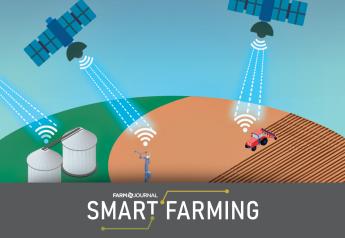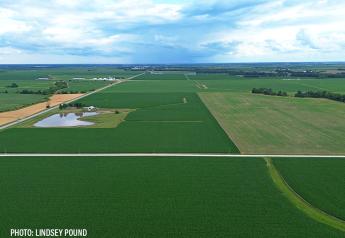Wearable Sensors Gauge Water Use

Want to know how much water a corn plant is guzzling or how fast a soybean plant is drinking? Stick on a tattoo and get an instant real-time answer from a wearable plant sensor.
Applied in a simple, peel-and-stick adhesive fashion, a new graphene sensor measures leaf surface humidity, a function of how much water is transpired by crop plants. From on-the-go crop management to plant breeding, the innovative technology is layered with potential for agriculture.
Iowa State University’s (ISU) Plant Sciences Institute (PSI), steered by Patrick Schnable, is made up of plant biologists, computational scientists and engineers. When PSI’s Liang Dong, associate professor of electrical and computer engineering, tackled the challenge of precision crop water measurement, he came up with a tiny low-cost answer for a major issue.
Dong created an adhesive graphene sensor (which can be sized down to millimeters) sensitive to water vapor. The sensor measures how much water leaves the plant. Essentially the sensor records how much and how fast a plant drinks.
The graphene within the sensor exhibits different levels of conductivity depending on the humidity. The conductivity of the sensor can be measured by running an electrical current across it. The changes of conductivity serve as a moisture gauge, according to Schnable: “It acts like a mercury thermometer.
As the temperature goes up the mercury expands and goes up according to the corresponding temperature scale. The plant tattoo sensor reads water loss in a similar manner.”
A wire leads from the sensor to a small box on the stalk or at the bottom of the plant. The box converts the electrical current to data. Schnable and Dong plan to experiment with different Wi-Fi methods to deliver data to the cloud.
External humidity levels don’t affect sensor performance, Dong says: “For field applications, the sensor takes in local temperatures that will be fed to a readout circuit to eliminate any humidity effect on the sensor’s output.”
And dust? “The sensitive material of the sensor faces the leaf, and thus is physically protected by the tape from dust,” he adds.
Initial use will involve measuring drought tolerance in crop varieties and hybrids. However, farmland is where Schnable sees the biggest impact. “We’re excited because farmers are going to be able to use these to make water management decisions. For example, they could put sensors on a number of plants in a pivot circle. The information from the leaves would be transmitted to the data analyzer, which could then communicate with the pivot and tell it how much water to put in which parts of the field.”
Schnable emphasizes the multi-crop use of the sensor and its fast set-up time. “Place the box and apply the sensor like adhesive tape; it’s that easy,” he says.
Field trials will take place in 2018 and 2019 in Iowa and Nebraska thanks to a three-year, $472,363 grant from USDA’s Agriculture and Food Research Initiative. Michael Castellano, William Frankenberger, professor of soil science and ISU agronomist, will direct the testing with Dong and Schnable. The team hopes to commercialize the sensors by 2020. (ISU’s Research Foundation has applied for a sensor patent.)
“Our wearable plant sensor technology may become a game-changing approach to agricultural water management and accelerate the process of breeding drought-tolerant crops,” Dong says.
“In the field, the challenge has been how to figure out what plants are doing with water,” Schnable says. “Now, with sensor technology that goes on as simply as a tiny Band-Aid, farmers can know exactly how much water their crops are using.”







